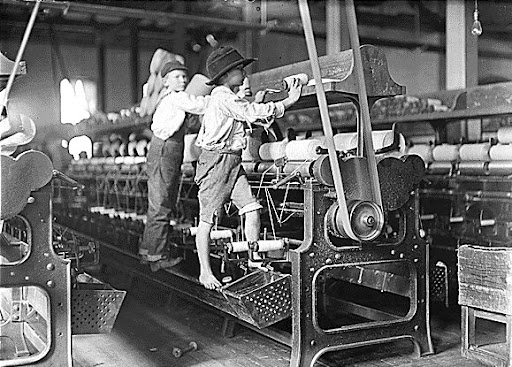Different Types of Child Slavery in Victorian Times
 Blacksmith: Being a blacksmith was a tenacious job that was a hard job for adults, let alone a child from ages 5-15. It required a lot of hard work and effort to mold metal into usable utensils and objects. Although being a blacksmith was not very easy, the economic and social position of it was much higher than compared to working on a farm or in a factory.
Blacksmith: Being a blacksmith was a tenacious job that was a hard job for adults, let alone a child from ages 5-15. It required a lot of hard work and effort to mold metal into usable utensils and objects. Although being a blacksmith was not very easy, the economic and social position of it was much higher than compared to working on a farm or in a factory.
Textile mills: working in Textile Mills is one of the worst places for a child to be, let alone be there around the clock. This laborious job causes children in the Victorian Era to have bad physical growth. Standing in an enclosed heated atmosphere for hours of not moving around is like telling a child to stand outside all day when its 110 degrees outside.

Child slavery in mines was very dangerous. In the mines, children were told to break walls open and search for any valuable objects. The walkway in a mine is very narrow and short, making it perfect for children to drag carts of coal through. A five year old dragging something that weights more than himself is an extremely difficult task, especially for a child that was underfed and weak. It was usual to see children accidentally slip. These events were common and fatal.

Child slavery in mines was very dangerous. In the mines, children were told to break walls open and search for any valuable objects. The walkway in a mine is very narrow and short, making it perfect for children to drag carts of coal through. A five year old dragging something that weights more than himself is an extremely difficult task, especially for a child that was underfed and weak. It was usual to see children accidentally slip. These events were common and fatal.

Chimney sweeping: Before mines, chimney sweeping was the most difficult and most dangerous job there was. Children were apprenticed and taught how to get inside a chimney and clean out all the soot and creosote. Young children were used for this because of the small opening. It was quite often that children would get burnt, fall, or suffocate from the debris.

Farmers in the Victorian Era were very common, especially within family members. Children started working in the field at around age five. Being a farmer during this era was risky because of the unpredictable weather conditions. They had to be very careful with soil and watering. Farming could mean being outside in the beaming sunlight all day.
Prostitution in the Victorian Era was considered "a fate that's worse than death" to women. Men with money were willing to pay a standard pricing of about twenty pounds for a healthy working-class girl between the ages of fourteen and eighteen. Men were willing to pay a hundred pounds for a middle-class girl of the same age; and as much as four hundred pounds for a child from the upper class under the age of twelve. It was very common for a young girl to experience their first sexual experience this way. Not only that, but it was also common to get a sexually transmitted disease because of no safe treatment.
Child Maids: At around the age of twelve, children were hired to work as maids or nursery maids. Maids were normally girls that helped take care of children or clean around the house. When older maids were hired, they were expected to cook food for their master. Life as a maid wasn't very good, but it was considered alright just because your master would provide food for you to eat.
Thieves: Being a thief in the Victorian Era was risky. It took a lot of time to become a skilled thief. They were usually taught techniques to use to take someone's belongings. For example: in the book Oliver Twist, Charles Dickens uses the character Fagin to show us how he taught his “students” to steal. When you were a thief, your boss expected you to come back with money or something of good value. Therefore, if you came back empty handed, you would have most likely been punished.
Piecers were children that worked in linen factories. They inspected all threads to make sure they were connected. If the reel of threads was broken, they had the job of piecing it back together. That is where they got the name of piecers. This job was very time consuming and boring.
Scavenger: A scavenger's job was to get under the factory’s machines, and get all the bits of fluff that got caught there. Being a scavenger was hazardous for children because they could easily get caught under the machinery and die, or get seriously injured.
Catcher: In the Victorian Era it was common to see child slavery. At the brick yards, children were used to re-stack bricks. They would toss bricks to each other in a line to shift the piles of bricks to another side of the yard.



No comments:
Post a Comment